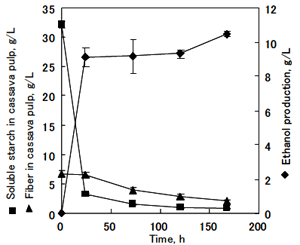Direct ethanol production from cassava pulp using arming yeast co-displaying amylolytic, cellulolytic enzymes and s-glucosidase
Description
Cassava (Manihot esculenta Crantz) which contains high starch concentration is a major raw material used in many industries in the tropical areas. When starch is extracted from cassava tubers in the tapioca starch processing, the grated cassava tubers are separated into starch granules and fibrous residual materials. These fibrous residual materials, named as cassava pulp, correspond to around 10% to 30% of original tubers as solid waste, and it contains a large amount of starch (about 60% dry base), high moisture (70-80%), and little cellulosic fibers. We tried to produce ethanol from cassava pulp using arming yeast.
We constructed a yeast strain that displays two amylolytic enzymes (AM and GA) and two kinds of cellulolytic enzymes (EGII and CBHII) and BGL1 on the yeast cell surfaces by arming technology (utilizing the various proteins displayed on the cell surfaces using genetic engineering techniques) (Fig.1). These enzymes were co-displayed on the surfaces of the arming yeast cells, and because of this, the arming yeast can bring the activities of all the enzymes (Table 1). Five percent (5%) of cassava pulp that was pretreated with water at 150 ºC for 60 min was directly fermented using the arming yeast. Fermentation was performed at 30 ºC in fermentation medium containing 50 g of cassava pulp per liter as the sole carbon source. Starch and fiber components in cassava pulp were saccharified by the arming yeast, and 10.5 g/L ethanol was produced from 5% cassava pulp (Fig 2).
This arming yeast has five enzymes that are necessary to saccharify or breakdown starch and cellulose and it is able to produce ethanol without further enzymes addition during fermentation. Therefore, it is possible to contribute towards cost-cutting in ethanol production from biomass. The cells in flocs can be separated easily by sedimentation after fermentation, since this arming yeast is a flocculant yeast. On the other hand, the formation of cell flocs would reduce the effective concentration of the enzymes on the cell surfaces that can access the insoluble substrate such as cellulose for enzymatic reaction.
Figure, table
-
Fig. 1 Arming yeast that co-displays amylases, cellulases, and β-glucosidase on cell surfaces. -
Fig.2 The ethanol production from 5% cassava pulp as the sole carbon source by arming yeast. -
Table1. Enzyme activities of arming yeast displaying five enzymes on cell surface.
- Affiliation
-
Japan International Research Center for Agricultural Sciences Post-harvest Science and Technology Division
- Classification
-
Technical A
- Term of research
-
FY2008(FY2006~2010)
- Responsible researcher
-
MURATA Yoshinori ( Post-harvest Science and Technology Division )
APIWATANAPIWAT Waraporn ( Agro-Industrial Product Improvement Institute, Kasetsart University, Thailand )
KOSUGI Akihiko ( Post-harvest Science and Technology Division )
YAMADA Ryosuke ( Kobe University )
KONDO Akihiko ( Kobe University )
ARAI Takamitsu ( Post-harvest Science and Technology Division )
MORI Yutaka ( Post-harvest Science and Technology Division )
- ほか
- Publication, etc.
-
Murata et al. Nihon Seibutsu Kogakkai, August 2008, Sendai
Murata, Y., Apiwatanapiwat, W., Kosugi, A., Yamada, R., Kondo, A., Arai, T. and Mori, Y. (2008) Ethanol production from cassava pulp using surface-engineered yeasts codisplaying amylolytic and cellulolytic enzymes. The 5th Biomass-Asia Workshop.
Kosugi, A., Kondo, A., Ueda, M., Murata, Y., Vaithanomsat, P., Thanapase, W., Arai, T. and Mori Y. (2009) Production of ethanol from cassava pulp via fermentation with a surface-engineered yeast strain displaying glucoamylase. Renewable Energy.
- Japanese PDF
-
2008_seikajouhou_A4_ja_Part19.pdf519.54 KB



